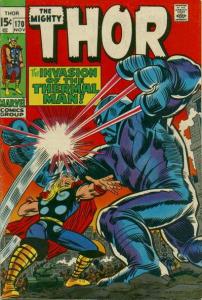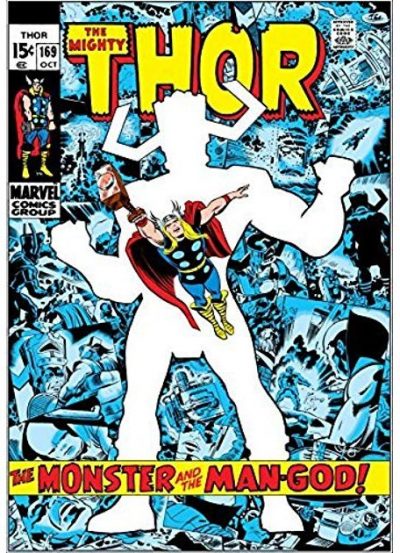
Cover to Journey into Mystery #1 (Jun., 1952). Art by Russ Heath.

Cover to Journey into Mystery #83 (Aug., 1962). Art by Jack Kirby and Joe Sinnott.
As milestone issues of long-running comic-book series go, Thor #200 is a fairly odd duck, for a number of reasons. The first, of course, is that it’s not really the 200th issue of “Thor“ at all; rather, it’s the two-hundredth sequential release of a periodical publication that began its existence in 1952 as Journey into Mystery, an anthology title which had nary a thing to do with the Norse God of Thunder until the Marvel version of that mythological figure made his debut in its 83rd issue, ten years into the book’s run.
Since the title of the publication wasn’t changed from Journey into Mystery to Thor until issue #126, there hadn’t ever been a Thor #100. (To the best of my knowledge, there hasn’t been one in later years, either, despite multiple relaunches of the series over the last few decades; and given Marvel’s current publishing model, which simultaneously incorporates both successive restarts and “legacy” numbering, there probably never will be.) The actual 100th issue of “Thor” as a continuing feature had been #182 — and though that was a pretty good issue, featuring a battle with Dr. Doom as well as marking the beginning of John Buscema’s multi-year tenure as the series’ new regular artist, it hadn’t taken any special note of the occasion. By the time issue #200 rolled around, however, Marvel had made the 100th issues of Fantastic Four and Amazing Spider-Man causes for celebration — and they were about to do the same with Avengers #100, which would arrive on stands one week after Thor #200 (it’ll also arrive on this blog one week from today, just in case you were wondering). With 200 being such a nice round number, it would have been surprising if Marvel hadn’t chosen to commemorate Thor‘s issue numbering reaching it, as arbitrary as the milestone was in some ways.
But all of that represents just one way that Thor #200 was somewhat off-model as commemorative issues go. Another was that the main story was a retread of a tale originally presented in 1966 (right around the time Journey into Mystery became Thor, coincidentally enough). And yet another was that that story was a fill-in — or, at least, it read like one. Read More















